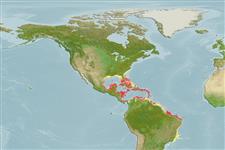Common names from other countries
>
Perciformes/Serranoidei (Groupers) >
Liopropomatidae (Painted basslets) > Liopropomatinae
Etymology: Liopropoma: Greek, leio = smooth + Greek, pro = in front of + Greek, poma, -atos = cover, operculum (Ref. 45335).
More on author: Poey.
Environment: milieu / climate zone / depth range / distribution range
Écologie
marin récifal; profondeur 3 - 45 m (Ref. 9710). Tropical
Western Atlantic: southern Florida, USA and Bahamas to northern South America.
Taille / Poids / Âge
Maturity: Lm ? range ? - ? cm
Max length : 10.0 cm TL mâle / non sexé; (Ref. 26938)
Épines dorsales (Total) : 6 - 7; Rayons mous dorsaux (Total) : 12. Body yellow-orange with 5 wide black lines along side bordered by red above and below. Large black spot on second dorsal fin; similar spot on anal fin; caudal fin has 2 black spots connected by black bar.
A solitary species (Ref. 26340) inhabiting deep recesses of coral reefs. Common, but secretive and rarely seen (Ref. 9710). The maximum size for this species is about 8 cm standard length or 100 mm TL (value from Ref. 26938) (P.Heemstra, pers.comm. 12/09).
Life cycle and mating behavior
Maturities | Reproduction | Spawnings | Egg(s) | Fecundities | Larves
Robins, C.R. and G.C. Ray, 1986. A field guide to Atlantic coast fishes of North America. Houghton Mifflin Company, Boston, U.S.A. 354 p. (Ref. 7251)
Statut dans la liste rouge de l'IUCN (Ref. 130435)
CITES (Ref. 128078)
Not Evaluated
Menace pour l'homme
Harmless
Utilisations par l'homme
Pêcheries: commercial; Aquarium: Commercial
Outils
Articles particuliers
Télécharger en XML
Sources Internet
Estimates based on models
Preferred temperature (Ref.
115969): 25.4 - 28, mean 27.2 (based on 200 cells).
Phylogenetic diversity index (Ref.
82804): PD
50 = 0.5000 [Uniqueness, from 0.5 = low to 2.0 = high].
Bayesian length-weight: a=0.01122 (0.00514 - 0.02450), b=3.04 (2.87 - 3.21), in cm Total Length, based on all LWR estimates for this body shape (Ref.
93245).
Niveau trophique (Ref.
69278): 3.7 ±0.6 se; based on size and trophs of closest relatives
Fishing Vulnerability (Ref.
59153): Low vulnerability (10 of 100).
